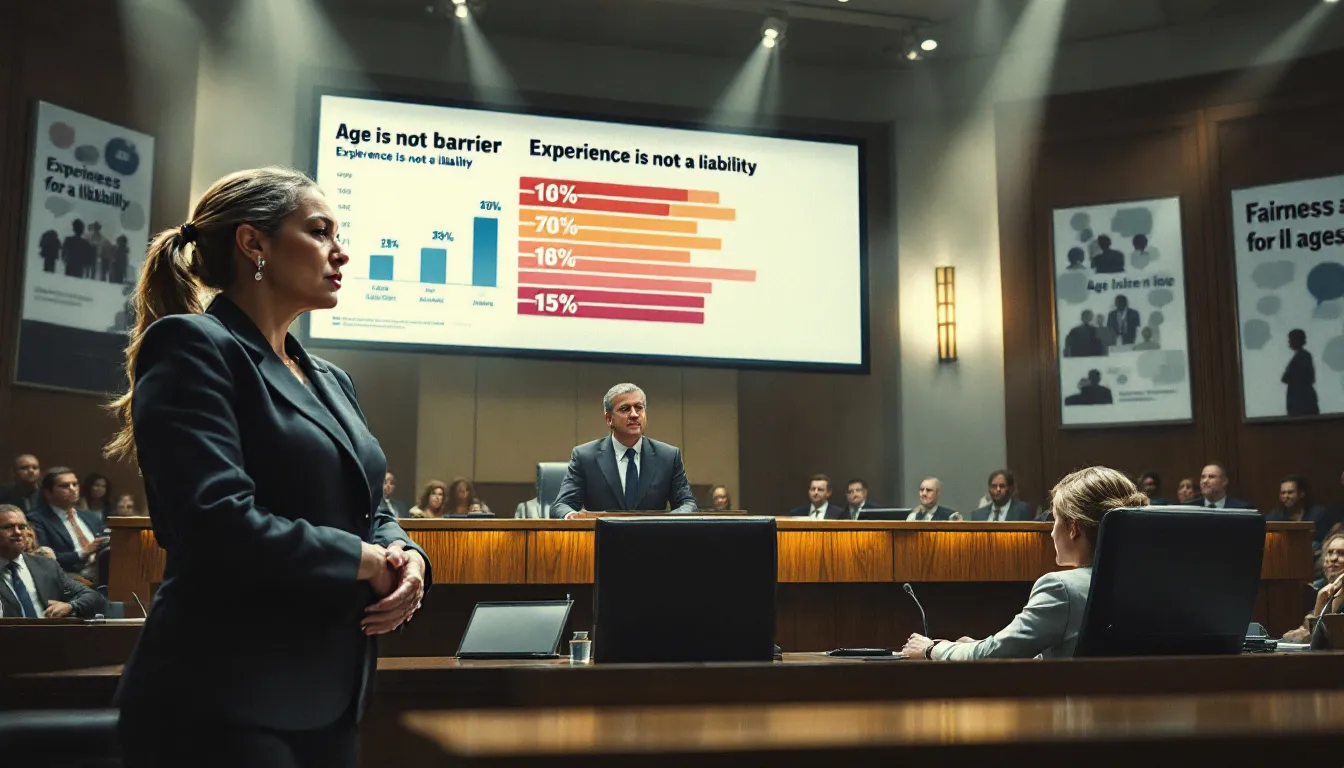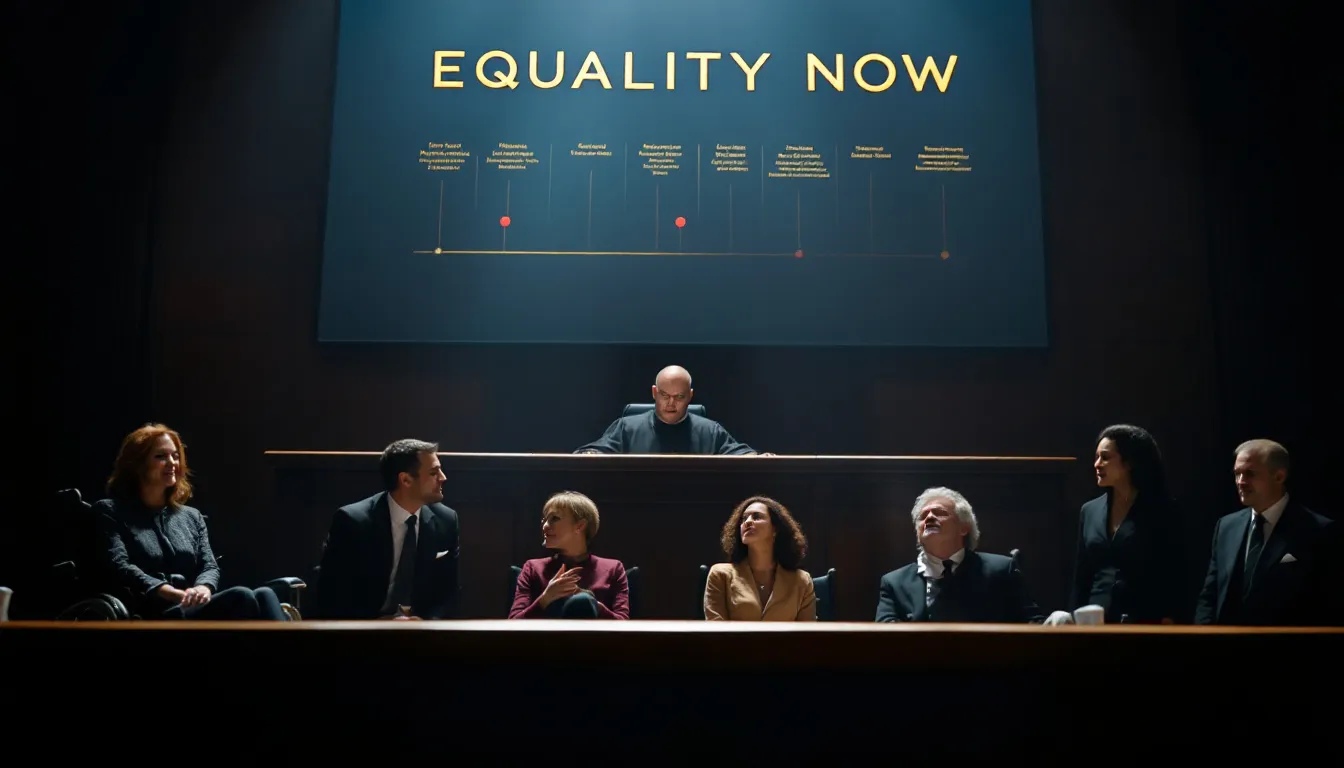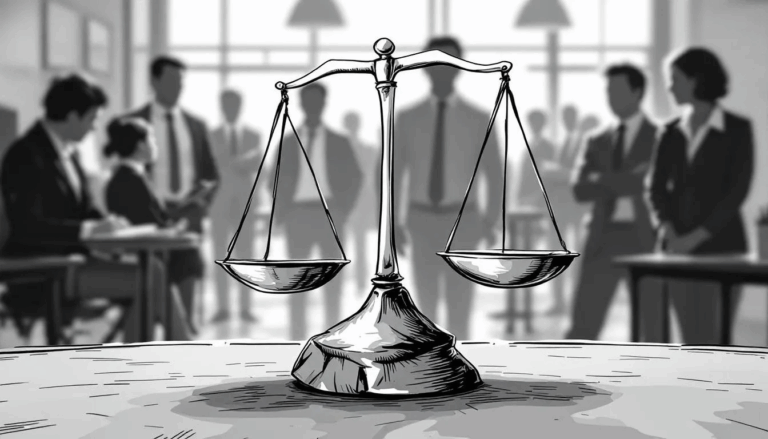This article covers landmark employment discrimination court cases that have shaped U.S. labor laws. In these cases, employers often must justify job disparities as a ‘business necessity’ to defend against employment discrimination lawsuits under Title VII of the Civil Rights Act of 1964. Learn about key rulings in cases involving race, gender, age, and disability discrimination, including Griggs v. Duke Power Co. and McDonnell Douglas Corp. v. Green. These cases reveal the legal standards that ensure workplace fairness.
Introduction to Employment Discrimination
Employment discrimination refers to the unfair and unequal treatment of individuals or groups in the workplace based on specific characteristics such as race, national origin, gender identity, sexual orientation, and more. The Equal Employment Opportunity Commission (EEOC) plays a crucial role in protecting employees from such employment discrimination.
Established under the Civil Rights Act of 1964, the EEOC enforces federal laws that prohibit employment discrimination. These federal laws, including Title VII, ensure that employees are treated fairly and equitably, regardless of their personal characteristics. By understanding these protections, employees can better advocate for their rights and seek justice when faced with discriminatory practices.
Types of Discrimination in the Workplace
Employment discrimination in the workplace can take many forms, each with its own unique challenges and implications. Age discrimination affects older workers, often limiting their career advancement opportunities. Disability discrimination can prevent individuals with disabilities from receiving reasonable accommodations. National origin discrimination targets individuals based on their ethnicity or country of origin. Pregnancy discrimination unfairly penalizes women for their pregnancy status.
Racial discrimination and sex discrimination remain pervasive issues, affecting minority groups and women in various ways. Sexual orientation discrimination targets LGBTQ+ employees, leading to unfair treatment and hostile work environments. The Supreme Court has addressed numerous employment discrimination cases, including those involving reverse discrimination, where majority groups claim unfair treatment. Understanding these different types of discrimination is essential for creating a fair and inclusive workplace.
Protected Classes
Protected classes are groups of people who are legally protected from discrimination under federal law. These classes include characteristics such as race, color, national origin, sex, age, disability, genetic information, and sexual orientation. For instance, African American employees and Hispanic workers have historically faced racial discrimination and national origin discrimination. Sex discrimination encompasses issues like pregnancy discrimination and sexual harassment.
Age discrimination specifically affects employees over the age of 40, while disability discrimination impacts individuals with physical or mental impairments. Recognizing and respecting these protected classes is crucial for fostering an equitable and inclusive work environment.
Employment Discrimination Laws
Employment discrimination laws are designed to protect employees from unfair treatment based on various characteristics. Title VII of the Civil Rights Act prohibits employment discrimination on the basis of race, color, national origin, sex, and religion. The Equal Pay Act addresses sex-based wage discrimination, ensuring that men and women receive equal pay for equal work. The Americans with Disabilities Act (ADA) prohibits disability discrimination, requiring employers to provide reasonable accommodations for employees with disabilities.
The Age Discrimination in Employment Act (ADEA) protects workers aged 40 and older from age discrimination. Additionally, the federal sector provision applies to federal employees, offering them specific protections. Understanding these laws helps employees recognize their rights and seek appropriate remedies when faced with discrimination.
Key Takeaways
- Landmark cases like Griggs v. Duke Power Co. and McDonnell Douglas Corp. v. Green have established essential legal standards for proving employment discrimination based on race and gender.
- Recent rulings, including Muldrow v. City of St. Louis, lower the burden of proof for employees seeking justice in discrimination claims, promoting fair treatment in the workplace.
- Understanding your rights and the complaint process is vital for employees who face discrimination; taking timely, informed action can significantly affect the outcome of their cases.
Landmark Employment Discrimination Cases

Landmark employment discrimination cases have set the foundation for the legal protections we have today. These cases have addressed various forms of employment discrimination, from race and gender to age and disability, and have established crucial precedents that continue to influence workplace policies and practices.
The following subsections highlight three key cases that have significantly impacted employment discrimination law: Griggs v. Duke Power Co., McDonnell Douglas Corp. v. Green, and Muldrow v. City of St. Louis, Missouri. Each case sheds light on different aspects of discrimination and the legal standards required to prove such claims.
Griggs v. Duke Power Co.
Griggs v. Duke Power Co. is a landmark case that established the principle of disparate impact discrimination under Title VII of the Civil Rights Act. The case arose when African American employees at Duke Power Company challenged the company’s transfer policy, which required high school diplomas and certain standardized test scores for job transfers. The Supreme Court found that these requirements disproportionately affected minority employees and were not directly related to job performance, thus violating Title VII.
The Griggs v. Duke Power Co. case highlighted the need for employers to justify job requirements as a ‘business necessity’ to avoid disparate impact discrimination.
This ruling clarified that employment practices, even if seemingly neutral, must be related to job performance to avoid disparate impact claims. Employers must ensure that their job related policies do not inadvertently discriminate against protected groups, highlighting the importance of fair and equitable workplace policies for a reasonable employee.
McDonnell Douglas Corp. v. Green
In McDonnell Douglas Corp. v. Green, the Supreme Court created a framework for establishing a prima facie case of racial discrimination. The case involved an African American employee, Percy Green, who alleged that he was not rehired by McDonnell Douglas due to his race and involvement in civil rights activities.
The Court ruled that to establish a prima facie case, the complainant must provide specific factual evidence showing that they are a member of a protected class, were qualified for the job, and were rejected under circumstances suggesting discrimination.
Once a prima facie case is established, the defendant bears the burden of proof to provide non-discriminatory reasons for the employment decision. This framework has become a cornerstone in racial discrimination cases, guiding both plaintiffs and defendants in presenting their arguments regarding national origin.
Muldrow v. City of St. Louis, Missouri
Muldrow v. City of St. Louis, Missouri, is a recent Supreme Court case that has made it easier for employees to pursue discrimination claims under Title VII of the Civil Rights Act, including cases of violation of Title VII. The case involved Jatonya Clayborn Muldrow, who alleged that her lateral transfer within the police department resulted in a decrease in job prestige and quality of responsibilities.
The Supreme Court ruled that employees alleging discriminatory job transfers allegedly discriminated only need to demonstrate ‘some harm’ regarding identifiable terms or conditions of employment, rather than a ‘significant’ disadvantage, including any tangible employment action.
This decision has significant implications for workplace equality, as it lowers the threshold for proving harm in discrimination claims. The Supreme Court’s decision in Muldrow v. City of St. Louis, Missouri, underscores the necessity for either the employer or the employee to demonstrate the reasonableness of adverse employment actions as determined by court precedents.
Supported by organizations like the American Civil Liberties Union, this ruling marks a victory for employees seeking fair treatment in the workplace.
Age Discrimination Cases

Age discrimination can severely impact older workers, limiting their career advancement and forcing them into early retirement. The Age Discrimination in Employment Act (ADEA) prohibits discrimination against individuals aged 40 and older in employment decisions, ensuring that age is not a factor in hiring, promotion, or termination.
In age discrimination cases, plaintiffs must often meet the legal standard of ‘but for causation’ to prove that the adverse employment action would not have occurred but for their age.
The following subsections discuss two pivotal age discrimination cases: Gross v. FBL Financial Services, Inc. and Meacham v. Knolls Atomic Power Laboratory. These cases highlight the challenges older workers face and the legal standards required to prove age discrimination.
Gross v. FBL Financial Services, Inc.
In Gross v. FBL Financial Services, Inc., the Supreme Court addressed the burden of proof in age discrimination cases under the ADEA. The plaintiff, Jack Gross, alleged that his demotion was due to age discrimination. The Court ruled that to establish a claim, the plaintiff must show that age was the decisive factor in the employment decision.
The Court’s ruling emphasized the ‘but for causation’ standard, requiring plaintiffs to show that age was the decisive factor in the employment decision. This requirement emphasizes the need for strong evidence directly linking age to the discriminatory action.
This decision places a significant burden on plaintiffs, as they must provide compelling evidence to counter the employer’s explanation for the employment decision. The ruling underscores the importance of gathering substantial proof when alleging age discrimination.
Meacham v. Knolls Atomic Power Laboratory
Meacham v. Knolls Atomic Power Laboratory is another critical case in age discrimination law. The case arose when Knolls Atomic Power Laboratory laid off a significant number of older employees, leading to claims of age discrimination. The Supreme Court ruled that the employer must prove that its actions were based on legitimate business reasons rather than age.
This ruling shifts the burden of proof to the employer, requiring them to demonstrate that their employment practices are based on factors other than age. The decision reinforces the protections for older workers under the ADEA and highlights the importance of legitimate business justifications in employment decisions.
Gender and Sexual Orientation Discrimination

Gender and sexual orientation discrimination continue to be significant issues in the workplace, including workplace discrimination. Despite progress in recent years, many employees still face unfair treatment based on their gender identity or sexual orientation, including same sex sexual harassment. The Equal Employment Opportunity Commission (EEOC) and Title VII of the Civil Rights Act provide protections against such discrimination.
An employer’s decision not to hire or accommodate an employee based on gender identity or sexual orientation can lead to liability under Title VII.
The following subsections explore two landmark cases: Price Waterhouse v. Hopkins and Bostock v. Clayton County. These cases have expanded the understanding of sex discrimination to include gender stereotypes and sexual orientation.
Price Waterhouse v. Hopkins
Price Waterhouse v. Hopkins is a landmark case that established that adverse actions based on gender stereotypes can constitute discrimination. Ann Hopkins, the plaintiff, claimed she was denied a partnership at Price Waterhouse because she did not conform to traditional female stereotypes. The Supreme Court ruled that gender stereotypes could be a valid basis for a sex discrimination claim under Title VII.
This case introduced the mixed-motive framework, where both legitimate and discriminatory reasons for an employment decision can coexist. It has significant implications for sex discrimination claims, as it recognizes the motivating factor of gender stereotypes in the workplace.
Bostock v. Clayton County
Bostock v. Clayton County marked a significant expansion of employment protections for LGBTQ+ individuals under federal law. The case involved Gerald Bostock, who alleged that he was fired because of his sexual orientation. The Supreme Court ruled that discrimination based on sexual orientation falls under sex discrimination in Title VII of the Civil Rights Act.
This decision confirmed that Title VII protections extend to LGBTQ+ employees, ensuring that they are safeguarded against discrimination in the workplace. The ruling has been hailed as a major victory for LGBTQ+ rights, reinforcing the importance of equal treatment for all employees.
Racial Discrimination and Equal Protection

Racial discrimination remains a pervasive issue in many workplaces. The Equal Protection Clause of the Fourteenth Amendment and Title VII of the Civil Rights Act provide legal frameworks to combat racial discrimination and illegal discrimination, ensuring equal treatment for all employees.
Race discrimination cases often rely on statistical evidence to establish a prima facie case of discriminatory intent.
The following subsections discuss two significant racial discrimination cases: Hazelwood School District v. United States and Washington v. Davis. These cases highlight the role of statistical evidence and the standards for proving discriminatory intent.
Hazelwood School District v. United States
In Hazelwood School District v. United States, the Supreme Court addressed the use of statistical evidence in proving racial discrimination. The case involved allegations that the Hazelwood School District discriminated against African American teachers in hiring practices. The Court ruled that statistical data can be used to establish a prima facie case of racial discrimination.
The case highlighted the importance of statistical evidence in proving race discrimination in employment practices.
The appropriate comparison for determining discrimination was between the racial makeup of Hazelwood’s teachers and the available teachers in the relevant labor market. This ruling underscores the importance of using statistical evidence to identify and address racial discrimination in employment practices.
Washington v. Davis
Washington v. Davis is a pivotal Supreme Court case that addresses the standards for proving discriminatory intent in equal protection claims. The case arose from allegations that the recruiting procedures of the Washington, D.C., police department disproportionately excluded African American applicants.
The Supreme Court ruled that discriminatory intent must be demonstrated and cannot be inferred solely from a disparate impact claim. This decision emphasizes the need for direct evidence of intentional discrimination in equal protection claims, reinforcing the importance of thorough and fair recruitment practices.
The ruling has significant implications for how racial discrimination cases are argued and adjudicated in the court of appeals and federal court.
Religious and Disability Discrimination

Religious and disability discrimination are critical issues that affect many employees. Title VII of the Civil Rights Act and the Americans with Disabilities Act (ADA) provide protections against such discrimination, ensuring that employees’ religious beliefs and disabilities are respected and accommodated. Employers must demonstrate that granting religious accommodations would lead to substantial increased costs relative to the operations of their particular business.
The following subsections explore two notable cases: Equal Employment Opportunity Commission v. Abercrombie & Fitch Stores, Inc. and Clackamas Gastroenterology Associates, P.C. v. Wells. These cases highlight the importance of accommodating religious practices and the classification of employees under the ADA.
Equal Employment Opportunity Commission v. Abercrombie & Fitch Stores, Inc.
The case of Equal Employment Opportunity Commission v. Abercrombie & Fitch Stores, Inc. set a significant precedent regarding religious accommodations in the workplace. The Supreme Court ruled that an employer’s duty to accommodate an employee’s religious practices exists even if the employee did not explicitly request accommodation. Samantha Elauf, a Muslim woman, was denied employment at Abercrombie & Fitch because of her hijab, which the company argued violated their dress code policy.
The Court held that an employer could be liable for not hiring someone to avoid accommodating their religious practices, even if the need for accommodation was not directly communicated by the applicant. This ruling underscores the importance of employers proactively ensuring that their workplace policies do not inadvertently discriminate against employees’ religious practices.
Clackamas Gastroenterology Associates, P.C. v. Wells
Clackamas Gastroenterology Associates, P.C. v. Wells addressed the classification of shareholders and directors as employees under the ADA. The Supreme Court focused on whether four physician shareholders were considered employees, which would entitle them to protections under the ADA. The Court determined that control over a worker’s duties is a key factor in deciding if they should be classified as employees.
This ruling clarified that shareholders in a company might still be classified as employees if they do not have substantial control over the company’s operations. The decision has significant implications for how companies classify their workers and the protections they are afforded under the ADA.
Reverse Discrimination
Reverse discrimination occurs when members of a majority group, such as white employees or male employees, claim they have been unfairly treated in favor of minority groups. This form of intentional discrimination can be just as damaging as traditional discrimination. Consent decrees and settlements are often used to resolve reverse discrimination cases.
The Supreme Court’s decisions in these cases provide guidance on the viability of reverse discrimination claims. Employers must be vigilant in preventing discrimination against all employees, regardless of their protected class. Implementing ongoing training and diversity education programs can help create an inclusive workplace and reduce the risk of reverse discrimination. By fostering a culture of fairness and equality, employers can ensure that all employees are treated with respect and dignity.
Retaliation and Harassment Claims
Retaliation and harassment claims are crucial aspects of employment discrimination law. Retaliation occurs when an employer takes adverse actions against an employee for engaging in protected activities, such as filing a discrimination complaint. Harassment can take various forms, including verbal, physical, and visual, and can create a hostile work environment.
The evidence presented in retaliation and harassment claims must allow a reasonable jury to reject the employer’s non-discriminatory explanation.
The following subsections discuss two important cases: Burlington Northern & Santa Fe Railway Co. v. White and Staub v. Proctor Hospital. These cases highlight the standards for proving retaliation and the liability of employers for supervisors’ discriminatory actions.
Burlington Northern & Santa Fe Railway Co. v. White
Burlington Northern & Santa Fe Railway Co. v. White broadened the interpretation of what constitutes an adverse action in retaliation claims. Sheila White, the plaintiff, was reassigned to a less desirable position after filing a sexual harassment complaint. The Supreme Court ruled that any action that could dissuade a reasonable worker from making a complaint qualifies as an adverse action.
This decision emphasized that adverse actions in a retaliation claim are not limited to formal employment actions like demotions or terminations but can include any negative change in job assignments or conditions, including tangible employment actions. The ruling prohibits retaliation and includes an anti retaliation provision that provides stronger protections for employees who face retaliation for asserting their rights.
Staub v. Proctor Hospital
Staub v. Proctor Hospital addresses employer liability for the discriminatory acts of supervisors. Vincent Staub, a member of the U.S. Army Reserve, claimed that his supervisors’ bias against his military obligations led to his wrongful termination. The Supreme Court ruled that an employer could be held responsible for the discriminatory behavior of supervisors that influences employment decisions, even if the final decision-maker was not directly biased.
This ruling highlights the importance of holding employers accountable for the actions of their supervisors and ensuring that employment decisions are free from discriminatory motives, reflecting the employer’s decision to implement robust anti-discrimination policies and training within organizations.
Filing a Discrimination Complaint
Filing a discrimination complaint is a critical step for employees who believe they have been subjected to unfair treatment. Understanding the process and knowing your rights can significantly impact the outcome of your case. The Equal Employment Opportunity Commission (EEOC) plays a vital role in handling discrimination complaints and ensuring that federal laws are upheld.
The following subsections provide a detailed guide on understanding your rights, the steps to file a complaint, and what to expect after filing. These insights can help employees navigate the often complex legal landscape of employment discrimination.
Understanding Your Rights
Federal laws provide robust protections against employment discrimination on various grounds, including race, gender, age, disability, and pregnancy discrimination. It is crucial for employees to be aware of these rights to effectively advocate for themselves. Sufficient evidence and demonstration of discrimination increase the likelihood of success in an employment discrimination case, particularly under the federal sector provision.
Employees can also sue a former employee for post-employment actions, such as retaliation, under Title VII, highlighting the comprehensive nature of these protections. Understanding your rights is the first step in challenging unfair treatment and seeking justice.
Steps to File a Complaint
When filing a discrimination complaint, it is essential to follow specific steps to ensure your case is heard. Start by contacting an EEO counselor within 45 days of the discriminatory action. After receiving a Notice of Final Interview, you must file a formal complaint within 15 days.
In a notable case, a heterosexual woman filed a reverse discrimination lawsuit against the Ohio Department of Youth Services, highlighting the challenges in proving such claims.
Providing detailed information, including dates and descriptions of the discriminatory actions, is crucial. This documentation helps establish the facts of the case and supports your claims during the investigation process.
What to Expect After Filing
After filing a discrimination complaint, an investigation process begins, where evidence is gathered and reviewed. Complainants should understand their rights under the law, which provides protections against discrimination, including those outlined in the due process clause.
Potential outcomes of the investigation can include settlement negotiations, further legal proceedings, or dismissal of the complaint if it does not meet specific criteria. Knowing what to expect can help you prepare for the various stages of the process clause and advocate effectively for your rights, including seeking an appropriate remedy.
Summary
Reflecting on the landmark employment discrimination cases discussed, it is evident that these rulings have significantly shaped the legal landscape, providing critical protections for employees. From race and gender to age and disability, these cases highlight the importance of standing up against unfair treatment and seeking justice.
In some cases, district courts may grant summary judgment to the employer if the employee does not present sufficient evidence to support their discrimination claims.
Understanding your rights and the legal standards required to prove discrimination is crucial for navigating the complexities of employment law. By staying informed and advocating for fair treatment, employees can contribute to a more equitable and inclusive workplace for all.
Frequently Asked Questions
What is employment discrimination?
Employment discrimination is essentially when someone faces unfair treatment at work because of traits like their race, gender, or disability. It’s really about ensuring everyone has a fair shot, regardless of those characteristics.
How does the Civil Rights Act of 1964 impact employment discrimination?
The Civil Rights Act of 1964 prohibits employment discrimination based on race, color, religion, sex, or national origin, making it a crucial safeguard for employees. This law empowers individuals to challenge discriminatory practices and promotes a more equitable workplace.
What is the role of the Equal Employment Opportunity Commission (EEOC)?
The EEOC plays a crucial role in protecting employees from employment discrimination in the workplace, ensuring equal opportunity as mandated by the Civil Rights Act. It’s all about promoting fairness for everyone in their jobs!
What constitutes a prima facie case of discrimination?
To establish a prima facie case of employment discrimination, you need to show that you belong to a protected class, were qualified for the position, and faced rejection in a way that hints at discriminatory motives. It’s all about connecting the dots between your qualifications and the unfair treatment you experienced.
What should I do if I believe I have been discriminated against at work?
If you think you’ve faced employment discrimination at work and are a federal employee, reach out to an EEO counselor within 45 days and share all the details of your situation to back up your claim. It’s important to take this step promptly to ensure your concerns are addressed. If you are an employee of a company, here are some details on what you can do to protect yourself and reach out to an employment discrimination attorney.



